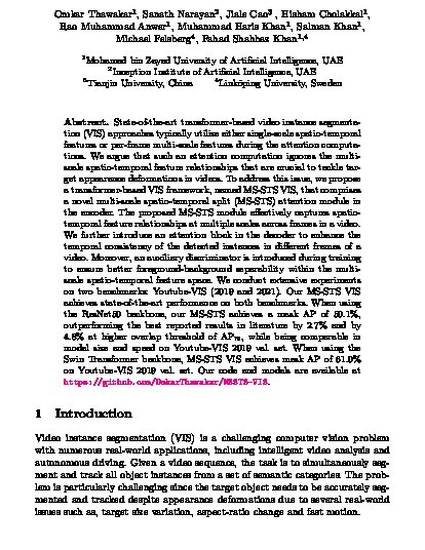
State-of-the-art transformer-based video instance segmentation (VIS) approaches typically utilize either single-scale spatio-temporal features or per-frame multi-scale features during the attention computations. We argue that such an attention computation ignores the multi-scale spatio-temporal feature relationships that are crucial to tackle target appearance deformations in videos. To address this issue, we propose a transformer-based VIS framework, named MS-STS VIS, that comprises a novel multi-scale spatio-temporal split (MS-STS) attention module in the encoder. The proposed MS-STS module effectively captures spatio-temporal feature relationships at multiple scales across frames in a video. We further introduce an attention block in the decoder to enhance the temporal consistency of the detected instances in different frames of a video. Moreover, an auxiliary discriminator is introduced during training to ensure better foreground-background separability within the multi-scale spatio-temporal feature space. We conduct extensive experiments on two benchmarks: Youtube-VIS (2019 and 2021). Our MS-STS VIS achieves state-of-the-art performance on both benchmarks. When using the ResNet50 backbone, our MS-STS achieves a mask AP of 50.1%, outperforming the best reported results in literature by 2.7% and by 4.8% at higher overlap threshold of AP 75, while being comparable in model size and speed on Youtube-VIS 2019 val. set. When using the Swin Transformer backbone, MS-STS VIS achieves mask AP of 61.0% on Youtube-VIS 2019 val. set. Source code is available at https://github.com/OmkarThawakar/MSSTS-VIS. © 2022, The Author(s), under exclusive license to Springer Nature Switzerland AG.
- Attention computation,
- Multi-scale features,
- Multi-scales,
- Multiple scale,
- Spatio-temporal,
- Spatiotemporal feature,
- Split attentions,
- State of the art,
- Temporal consistency,
- YouTube
Preprint available on arXiv: https://arxiv.org/abs/2203.13253

IR conditions: non-described